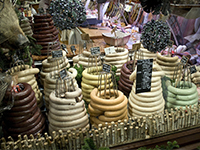 French boudin. |
Among Rohwursts would be all of the saucisson sec products (small dry sausages). Under kochwurst fall all of the boudins (both black and white). Brühwurst .....
 French boudin. |
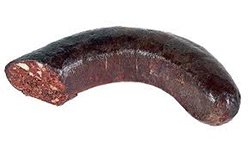 Black boudin (boudin noir). |
It is a blood sausage equivalent to the German Blutwurst or to the Czech jelito. Beside France, boudin noir is eaten in other francophone countries i.e. Switzerland and Belgium. It also exists in Britain where it is called black pudding, and eaten as part of the traditional English breakfast. It is eaten in Italy as "sanguinaccio", in Germany as Blutwurst, in Luxembourg as Träipen, and as "krovianka" in Russia.
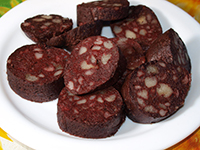 |  |  |
| Boudin à la viande from southwestern France. | German Blutwurst. | Czech dark tlačenka. |
The basic ingredients of boudin noir are a ground mixture (Brät) made from various parts of the pig, pig blood and pig fat, stuffed into pork-intestine casing. Additional ingredients may include Additional ingredients can include stale bread, onions, peppers, apples, chestnuts, raisins, or oats (in English black pudding). Like the Czech jelito, boudin noir is a typical product of a domestic slaughter. During domestic slaughter, blood would always be collected to make black pudding, jelito or boudin noir. In the preparation of boudin noir, it is mixed with one tenth of the volume of vinegar, slowly cooked and stirred with a wooden spoon so that it remains fluid. It is then mixed with the ground pork meat and fat, and stuffed into pork-intestine casings. Individual sausages 10-15 cm long may be made, or it is sold by length. The sausage is then rapidly cooked in boiling water. Regional variations include:
- Onion boudin (Boudin de Paris) made of 1/3 blood, 1/3 fat, 1/3 cooked onions, the only boudin that uses the ingredients equally
- Boudin Saint-Romain - a culinary specialty of Saint-Romain-de-Colbosc in Normandy made of 60% of blood, 30% raw onion and 10% cream.
- Boudin Valdôtain - a regional specialty from the Aosta Valley on the border between Italy, France and Switzerland, made from pig or cow blood, boiled potatoes, beetroot, bacon, and spices including cinnamon, nutmeg, sage, rosemary, juniper berries, garlic, salt, pepper - and red wine.
- Boudin à la viande - specialty of southwestern France, composed of 30-50% blood, the head of the pig, rinds and the tongue or heart are cooked in broth for several hours before being cut into small pieces and mixed with blood. After stuffing into casings, it is simmered at very low heat.
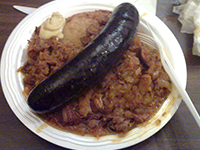 | 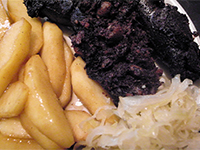 |
| Boudin noir a l'oignon. | Boudin de Saint-Romain. |
 | 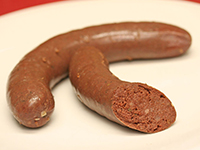 |
| Boudin à la viande. | Träipen, boudin from Luxembourg. |
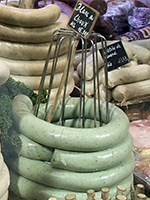 White boudin (boudin blanc). |
Variants of boudin blanc exist in French, Belgian, German, Cajun and Catalan cuisine. It is a culinary specialty, for instance, in the cities of Liège in Belgium, and Rethel and Essay in France. In France, the following boudin varieties exist:
- Boudin blanc Catalan containing eggs, from the eastern Pyrénées
- Boudin blanc Havre, a fatty pork sausage made with milk, eggs, bread crumbs and flour.
- Boudin with truffles, boudin blanc with black truffles (Périgord truffle or tuber brumale) with a precisely defined percentage, popular during the Christmas season
- "Malsat", from southwestern France (short sausages in cow-intestine casing)
- Boudin à la Richelieu made of poultry
- Boudin blanc de Rethel made exclusively from pork meat, fresh whole eggs and milk, without any bread crumbs or starches
- La bougnette de Castres made with eggs
- Le coudenou de Mazamet
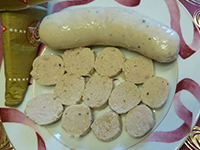 | 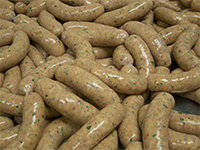 |
| Boudin de Rethel. | White boudin with truffles. |
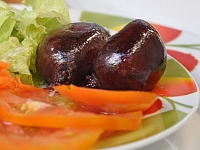 Boudin Créole. |
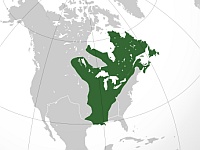 Nouvelle France: the French colonial expire in North America. Click to enlarge. |
In Louisiana, boudins are the local staple throughout the "Cajun Country", the area settled in the second half of the 18th century by French-speaking refugees from present-day Canada, expelled by the British when Nouvelle France was dismantled at the end of the Seven Year War in 1763. Toay, "Cajun Country" refers to the south of the state of Louisiana, with towns and cities bearing mostly French names like Abbeville, Broussard, Jeanerette, Lafayette, Opelousas, Plaquemine, St. Gabriel, St. Martinville, Ville Platte and Thibodaux.
 Pan-fried Cajun boudin. |
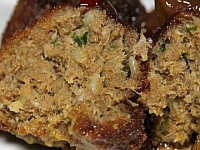 Alligator boudin. |
A boudin closer to the original French boudin noir is made in Illinois. The present-day state of Illinois lies far north from the Cajun Country and has historically nothing to do with it. The boudin noir from Illinois would therefore not he a Cajun boudin, as the Cajun population is limited to the coastal regions of southern Louisiana, but must stem from the original French settlers who came to Nouvelle France from Europe in the 17th and 18th centuries.

Another main family of French sausages are the Andouille sausages. The andouilles are a diverse bunch, reflecting numerous local traditions. The traditional French andouille is composed primarily of the intestines and stomach: the large intestine (40%), small intestine (about 43%), stomach (17%) without adding fat or binders. It is seasoned with salt, pepper, spices and herbs. Andouille sausage is often made in the form of an irregular cylinder 25-30 cm long, with a diameter of 4-6 cm , rounded at the ends. The string is left longer at one end, so that the sausage can hang. Many varieties exist in France, based on location and method of manufacturing. The best known are:
- Andouille Jargeau (60% pork meat, 40% guts)
- Andouille the Val-d'Ajol
- Andouille de Vire
- Andouille rustic
- Andouille Guémené
- Andouille Charlieu
- Andouille Couvin
- Andouille Baye
The word "andouille" in French is an insult, meaning a stupid person....
Andouille sausage should not be confused with andouillette, which is a very coarse sausage (if it can be called a sausage), made with pork, or occasionally veal, intestines or chitterlings, pepper, wine, onions, and seasonings. Tripe is sometimes used. It has its devotees, but we will tactfully steer clear of it in this essay...
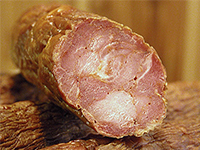 Cajun Andouille sausage. |
Cajun andouille sausage is an essential ingredient of the Louisiana gumbo soup.

 French saucisson sec. |
There are saucisson recipes dating from Roman times, and Gaulish recipes for dried pork. The word saucisson first appeared in France in 1546 in the Tiers Livre of Rabelais.
The stuffing of a French saucisson is the most wonderful part. The meat mixture consists of 2/3 to 3/4 lean meat, with the rest being fat. The mixture is ground to different degree of grain fine-ness, depending on the type of saucisson and mixed with salt, sugar, spices, nitrites and/or saltpeter, and with fermenting bacteria. But the best part is what comes next: some saucissons also contain things like whole peppercorns, garlic, bits of dried fruits, nuts such as pistachios, figs, olives, cheeses such as Roquefort, Laguiole, or alcohols such as wines and liquor. Where the German bratwurst is the king of the grilling sausage, the French saucisson sec generally ranks at the very top of the condiment pyramid. Sliced saucisson sec makes an unforgettable nibble-snack to go with wine.
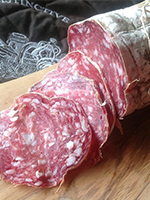 Rosette de Lyon, sliced thick. |
 Saucisson de Lacaune. |
 Saucisson d'Ardenne. |
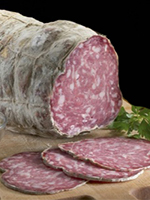 Jesus de Lyon. |
Saucisson d'Arles from Provence. |
 Saucisson à l'ail (garlick sausage). |
The saucisson de Lyon is a big sausage with a smooth texture. Outside of France, it is known as Lyoner in Austria and Germany and comes with additives such as pieces of pickled red pepper. In Germany or in the Czech Republic, it is usually eaten thinly sliced as a cold condiment or on a sandwich, but in France it can be seen served sliced thick and boiled with potatoes or with peas.
And now a few more delicious Rohwursts:
 Saucisson aux noisettes (Sausage with hazelnuts):
10% whole hazelnuts, 85% pork, 5% pork fat, natural pork-intestine casing.
Saucisson aux noisettes (Sausage with hazelnuts):
10% whole hazelnuts, 85% pork, 5% pork fat, natural pork-intestine casing.
- Saucisson aux pistaches (sausage with pistachios)
- Saucisson au beaufort: 85% pork, 10% pork fat, 56% Beaufort cheese. Beaufort cheese is a firm cheese made from raw cow milk, associated with the gruyère family. It is a cheese from the Alps, produced in Beaufort in the Savoie region of the French Alps.
 Saucisson au poivre (sausage crusted in ground peppercorns):
85% pork, 15% pork fat, natural pork-intestine casing.
Saucisson au poivre (sausage crusted in ground peppercorns):
85% pork, 15% pork fat, natural pork-intestine casing.
 Saucisson au herbes (sausage crusted in herbs):
85% pork, 15% pork fat, natural pork-intestine casing.
Saucisson au herbes (sausage crusted in herbs):
85% pork, 15% pork fat, natural pork-intestine casing.
- Saucisson aux noix (sausage with walnuts):
7% whole hazelnuts, 85% pork, 8% pork fat, natural pork-intestine casing.

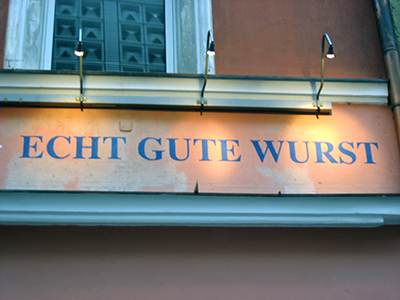
Sources:
- Fleischtheke.info
- Wurst.de
- Wikipedia
back to Radim and Lisa's Well-Travelled Cookbook | email us
Last updated: May 10, 2014
Certain images from Wikimedia Commons, used under the terms of the GNU Free Documentation License.